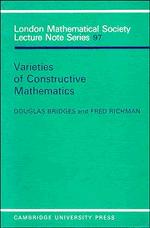4 - CONSTRUCTIVE ALGEBRA
Published online by Cambridge University Press: 04 April 2011
Summary
In which various examples are given to illustrate the problems and techniques of constructive algebra. As in Chapter 2, particular attention is paid to results whose classical counterparts are either routine or trivial, but whose constructive proof requires careful choice of definitions and hypotheses, and subtle technique. For example, in Section 6 there is given a constructive version of the Hilbert basis theorem, for which we need both the correct definition of a Noetherian ring, and the classically redundant hypothesis of coherence. The relationship between constructive and recursive algebra is illustrated in Section 4, which deals with the question of the uniqueness of splitting fields.
General considerations
Although several mathematicians, including Kronecker and van der Waerden, have made important contributions to constructive algebra, the main thrust of constructive mathematics has been in the direction of analysis. One reason for this is that all analysis is based on the real numbers, where constructive difficulties arise at the very outset; vast areas of algebra, on the other hand, deal with finite objects, such as polynomials over ℚ, and even with finite sets of objects, as in the theory of finite groups. Another possible explanation is that the main research interests of Brouwer, Markov, and Bishop lay outside algebra.
- Type
- Chapter
- Information
- Varieties of Constructive Mathematics , pp. 75 - 102Publisher: Cambridge University PressPrint publication year: 1987

